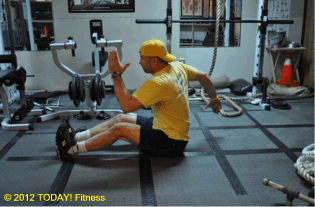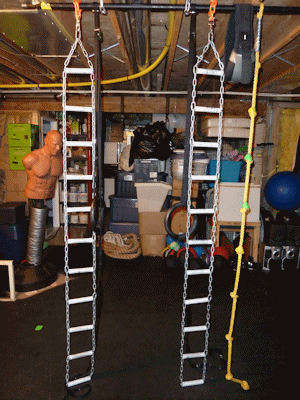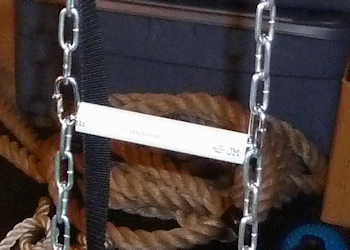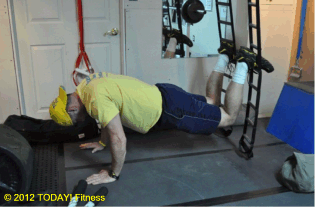|
My Leg
Hurts... I Can't Workout |
|
I've been considering writing
this article for quite some time. When it comes to
excuses, an injury is often difficult to argue with.
"No pain, no gain" simply does not apply when you are
dealing with injury (only post exercise muscle soreness).
However... sometimes it's tempting to take the easy way out
and just stop working out altogether!
I've been overweight before.
I've been sedentary before. Looking back, I now
realize that I did NOT like they way that felt! Once
you are addicted to exercise, it's your job to find a way to
keep it going if at all possible. Let me be clear
though... this does not apply to ALL injuries! You
certainly need to be careful with any injury to your neck,
back, or anything in the spinal column area. I'm
mostly referring to injuries of your extremities.
If your ankle or knee hurts,
it shouldn't prevent you from doing concentration curls,
bench press, lat pulldowns, abs etc... Likewise, a
wrist or hand injury shouldn't stop you from doing some
bodyweight squats, walking lunges, calf raises, abs etc...
I know, I know... but what
about the cardio? I run on the treadmill, or bike, or
do the elliptical, etc.. This can certainly be more
difficult to replace, but definitely not impossible!
In actuality, weight training is a type of interval
training. You have periods of work, followed by
periods of rest. If you want to get your heart rate
jacked up during your workout, just reduce the duration of
your rest periods. Periodically when I travel, or when
I want to change things up, I'll do a cardio routine with
100% sandbag exercises... and I can tell you that my
heart rate is jamming at the end of that one!
If you're still looking for a
replacement for that cardio machine, there are still other
options. Battling ropes have become popular in recent
years and will give you a killer cardio workout without
messing with your legs much. Have you ever tried
hitting the heavy bag that boxers use? Doing it right
certainly requires using more hip and legs, but you can
still get a workout by just pounding away at it. I
picked up a
RopeFlex machine recently
that kicks my butt extremely efficiently after a mere 2
minutes on it.
Here's something that you
don't see everyday... seated running. It's actually an
exercise used by track athletes to work on proper arm
movement. Sure, it looks stupid... but so does
sitting on your couch whining about not being able to
workout!

You should be moving your
arms with open hands for a full and exaggerated range of motion.
The pace
should be brisk enough to kinda bounce up and down on your butt.
It's been a while since I've done this, so I just took a
break from typing this newsletter and did a minute's
worth... breathing a little heavy right now
J. Once again, if the exercise requires a lot of effort that
you can't maintain for 30 minutes, this is an opportunity to
incorporate some rest periods so that you can recover and
then keep going (intervals).
Where there's a will, there's
a way! Be smart about knowing your limitations, and
check with a doctor if you are not sure. But don't be
so quick to write off your workout just because you have a
boo boo J.
So your ankle hurts?
Try these exercises. Pick a few and put them in a basic 2-3 sets each format, or do
them one after another with short rest periods in a circuit
format...
- seated running
- battling ropes
- heavy bag, speed bag
- elbow sprints (upper body
drag, no legs)
- bicycle crunch, curl ups,
L-sit raises (most ab exercises)
- russian twist (w/ med
ball, dumbbell, weight plate)
- bench press or pushups
- dumbell fly or pec deck
- lat pulldowns or chinups
- seated row or 1 arm row
- concentration curls, seated alt arm curls,
cable curls
- tricep kickbacks, tricep
extensions
- seated rear delts
- seated dumbbell press
- side leg raises
- dumbbells lateral raises
|
|
DIY USA |
|
I
recently received a response to my monthly newletter from a fellow
do-it-yourselfer, Ken Kenton, regarding his DIY version of the
USA. He used chain for his USA rather than straps or rope.
You can tell that this design is going to last for quite some time
compared to the original design!

I especially like the way that he
used the C couplings at each of the rung connections to join the 3
ends of the chain. Chain does require a bolt cutter or
similar tool to cut into pieces, but it is far superior in
durability to the rope and straps.

While very durable,
Ken estimated the construction costs of his chain USA at around
$100 for the pair, which really isn't too bad considering that my
pair of USA originals ran about $80 + shipping. Great job
Ken!
|
|

"upward dog" |
|
|
|
|
USA
Bodyweight Exercise of the Month! |
|
Suspended
Quad Extensions

Summary:
Although leg extensions (quadricep
extensions) are probably one of the first leg exercises that
people learn to do, they are also one of the least popular
exercises performed on suspension straps. This version
is actually tougher that it looks, especially when you take
your time and use a slow, controlled pace.
Target: upper legs and
core (quadriceps femoris, rectus abdominis)
Description: Start
with your hands in a pushup position, and your feet in the
straps at a height above your shoulders. Extend your
knee and raise your body up by pressing down with your
feet/ankle. Return slowly to the starting position and
repeat for repetitions.
|
|
Can I Exercise
with a Cold? |
|
By Steve Edwards,
Beachbody.com
Shut it down and get some
rest. It will help you get well sooner and it might
end up improving your results in the long term.
When you're sick, your body
uses its recovery properties to fight the illness. When you
exercise, you use these same properties to recover. To your
body, trying to exercise when you're sick is effectively the
same thing as overtraining. You won't be able to recover
from exercise, rendering it useless, as well as increasing
the risk of making your illness worse and lengthening your
downtime.
Believe it or not, there are
actually a couple of upsides to being sick. It both raises
your metabolism and heightens your immune response, meaning
that you can eat more than normal and not gain weight. Your
immune system also releases performance-enhancing hormones
that both fight the infection and help you heal microtrauma
incurred during your training program. Because of these
factors, when I'm sick during a training cycle I consider it
my recovery week. Here is my protocol:
At the onset of symptoms I
bump my vitamin C and zinc levels, drink a ton of water, and
sleep as much as possible. If I catch it early enough, I'll
miss the cold. However, your body plays an insidious trick
on you at the onset of a cold. Before you feel symptoms,
your adrenal system kick-starts the immune response, which
often results in a great workout—too good. Prior to a
competition, if an athlete sets a personal record or looks
too strong, their coach will often shut them down in
anticipation of potential pending illness. If a workout
feels spectacular out of the blue, consider backing off and
adding immune-boosting supplements to your regimen.
Once I know I'm sick, I rest
as much as I possibly can. I clear my social schedule, work
as little as possible, and shelve any projects (even mental
ones) that can wait. My diet becomes very clean. No coffee,
alcohol, sugar, junk, and I drink a ton of water. Also, I
eat a lot of small meals all day long. Your body needs
nutrients when it's sick but doesn't want the energy burden
of digesting large meals.
When the cold has turned the
corner I begin moving more. I'll do low-level aerobic
exercise and light yoga—restorative exercise. I'll build
this gradually as I feel better, so that when the symptoms
are gone I can hit it hard, right where I left off. When I
follow my protocol strictly it will actually aid my fitness
program in the long run.
Finally, there are times when
you're sick when hard exercise might help, but it's rare.
The most common is near the end of a cold, where the
infection has run its course but you still have minor
symptoms. You might have heard someone say, "I blew the cold
out of my system" with exercise. Just be careful you don't
try this too early or you'll get worse. Patience may not be
your favorite part of training, but sometimes you gotta not
do what you gotta not do.
|
|
Anatomy of Your
Thigh |
Just thought that I would throw
some technical jargon into the newsletter to take up some
space J.
Most people know where their "thigh" is... some people are
also aware that the front of their thigh is called the
quadriceps, and the back of the thigh is the hamstrings.
Let's break it down a little further...
 |
Quadriceps
(quadriceps femoris)
a large muscle group that includes the four prevailing
muscles on the front of the thigh. It is the great
extensor muscle of the knee, forming a large fleshy mass
which covers the front and sides of the femur.
- vastus femoris
(internal)
- vastus
medialis
- vastus
lateralis
- rectus
femoris
|
Hamstrings
any one of the
three posterior thigh muscles that make up the borders of
the space behind the knee, or their corresponding tendons.
- biceps
femoris
-
semimembranosus
-
semitendinosus
|
 |
Of course, there
are more muscles in your upper leg than just the quads and
hammys, but I didn't want to get too carried away and cause
you to drool all over your keyboards ; )
|
|
It's Go Time!
|
|
Here we go... it's the last month of 2012.
How was your year? Looking back to reflect on it, what
would you do differently? That's a pretty open ended
question which can take us off on all sorts of tangents...
I'll rephrase that, what would you do differently in the
health and fitness realm? Did you work out as much as
you planned to last year? Did you eat healthier than you
did in 2011? Did you start to incorporate more
stretching in your routine? Cardio? Weights? If
you answered no to any of these questions... grab a pencil and
a piece of paper and start righting stuff down now! This
is how you start to develop your goals for 2013.
Goals should be SMART. SMART goals are
Specific, Measurable, Attainable, Realistic, and Time Bound.
I want to start running next year is not a SMART goal. I
will start running 2 miles per day, 3 days per week, starting
next week... and compete in my first 5K run in May is a SMART
goal. Write them down, post them on your wall, and
update them if you need to... but make a plan for yourself!
Oh, and by the way... you need not wait until New Years to
incorporate them into your "resolution". If you're
serious about it, why not start TODAY?
For
prior issues of this eNewsletter, to subscribe, or
unsubscribe, please visit the following
link -->
todayfitness.net/news.
Exceed Your
Potential!
Pete
Mazzeo, CPT
pmazzeo@todayfitness.net
"Good
enough never is."
- Debbi Fields
youtube of the month -->
Strength Training
..
for the combat athlete. Mostly a promo, but still
motivation for mixing up your training modalities.
|
|